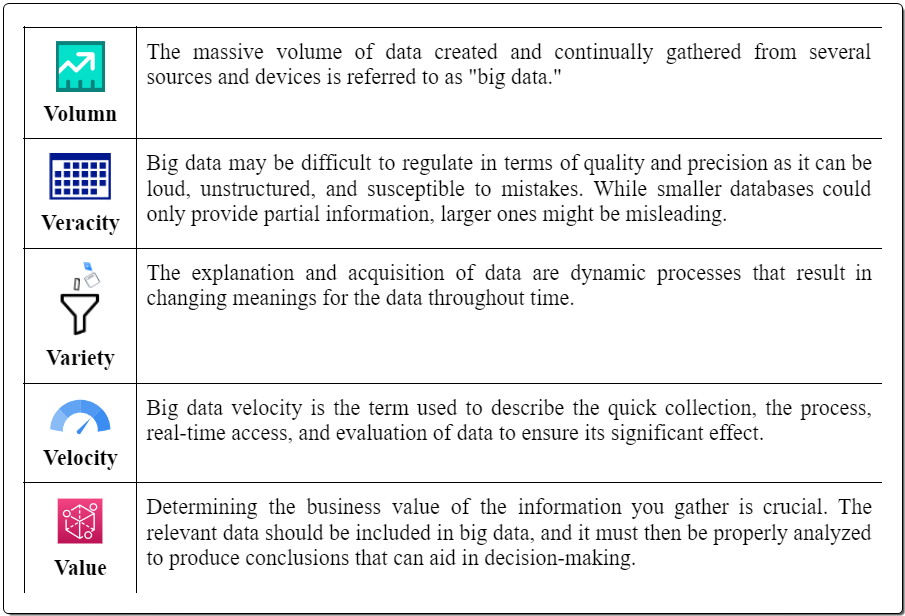BIG DATA AND MACHINE LEARNING
The domains of Big Data and Machine Learning are gaining popularity amongst data analysts and experts, making significant contributions to the achievement of numerous enterprises.
Big data and machine learning are closely linked, as big data deals with an enormous amount of information that conventional storage systems find difficult to handle. Machine learning, however, is a technique that uses this extensive data set to acquire knowledge and make intelligent forecasts and choices. Machine learning utilizes big data to access a vast amount of valuable business information, allowing organizations to make well-informed choices and maintain an edge over competitors.
Several organizations are integrating machine learning and big data technology to efficiently handle, store, and analyze vast quantities of data. Machine learning is essential for firms to address the problems presented by the large volumes of data they gather. The correlation between big data and machine learning is substantial and intricate. Prior to exploring these technologies in further detail, it is crucial to comprehend their interconnections.
What is Big Data?
Big Data encompasses vast quantities of data that pose challenges in terms of storage and management when utilizing conventional database systems. The sector encompasses both organized and disorganized data, providing ample opportunities for anyone interested in continuing a career in the IT business.
The issues associated with Big Data arise from its exponential expansion and the requirement to efficiently manage both organized and unorganized data. A multitude of firms depend on Big Data technologies to efficiently manage their operations and extract valuable insights from the vast quantities of data they accumulate. Several primary obstacles in leveraging Big Data are efficiently:
- Acquiring
- Arranging
- Storing
- Finding
- Sharing
- Transmitting,
- Evaluating
- Visualizing the data.
Resources
Big data may be gathered from many sources like publicly published remarks on social media platforms and web pages, personal electronic devices and applications, surveys, product transactions, and electronic registrations. The use of sensors in intelligent devices facilitates the gathering of data in many scenarios and conditions.
The V’s of Big Data
 Big Data with Machine Learning
Big Data with Machine Learning
While big data and machine learning are not incompatible with one another, their combination may produce amazing outcomes. Machine learning methods aid in handling the 5Vs in large data sets and provide precise predictions. With the help of analytics teams, big data enhances teaching strategies by extracting high-quality data. Businesses such as Google, Amazon, IBM, and Netflix have realized the potential of machine learning-enhanced big data analytics.
Every aspect of big data operations, including data labeling and segmentation, analysis of data, and scenario simulation, may benefit from the use of machine learning techniques, which are essential for gathering, analyzing, and integration. On the other hand, handling bulked data may be difficult, and handling unstructured data calls for expertise, algorithms, and processing power.
Machine learning makes it possible for systems or computers to draw lessons from the past while employing enormous data to make precise predictions. Better interactions with consumers, leadership and company operations follow from this. By offering a diversity of data, big data facilitates machine learning by enabling computers to learn from more or more training examples.
Businesses want qualified data scientists to integrate big data and machine learning. Both innovations, meanwhile, offer benefits and may realize the potential of enterprises.
How to Use Machine Learning with Big Data?
Machine Learning for Big Data Management
- Offers effective, automated solutions for integrating, analyzing, and acquiring data.
- Uses cloud computing to process massive data sources quickly.
- Relevant to simulation, data analytics, and data segmentation.
- Uses large data to create a big picture, classifies, and puts conclusions in formats that are easy to comprehend.
Conclusion
The ideas of big data and machine learning are examined in this article with an emphasis on their functions in the current data-driven environment. Large information sources that are difficult for conventional storage methods to manage are referred to as “big data,” and machine learning is the process of teaching computers how to derive predictions from data. By merging these innovations, structured and unstructured data from big data platforms may be used to improve each other’s skills. Because of this partnership, machine learning models are able to evolve and get better over time, opening up a world of opportunities for businesses to drive innovation across several industries and derive valuable insights from Big Data.
